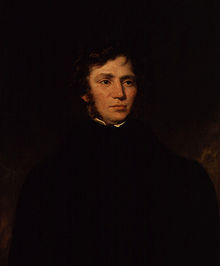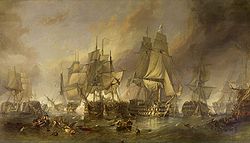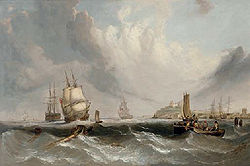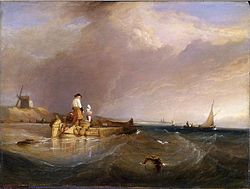- Clarkson Frederick Stanfield
-
Clarkson Frederick Stanfield (3 December 1793 – 18 May 1867) was a prominent English marine painter; he is often though inaccurately called William Clarkson Stanfield.
Contents
Early life
He was born at Sunderland, the son of James Field Stanfield (1749-1824) an Irish-born author, actor and former seaman. Clarkson was named after Thomas Clarkson, the slave trade abolitionist, whom his father knew, and this was the only forename he used, although there is reason to believe Frederick was a second one.
Stanfield probably inherited artistic talent from his mother, who is said to have been an artist but died in 1801. He was briefly apprenticed to a coach decorator in 1806, but left owing to the drunkenness of his master's wife and joined a South Shields collier to become a sailor. In 1808 he was pressed into the Royal Navy, serving in the guardship Namur at Sheerness. Discharged on health grounds in 1814, he then made a voyage to China in 1815 on the East Indiaman Warley and returned with many sketches.
Scenery
In August 1816 Stanfield was engaged as a decorator and scene-painter at the Royalty Theatre in Wellclose Square, London. Along with David Roberts he was afterwards employed at the Coburg theatre, Lambeth, and in 1823 he became a resident scene-painter at the Drury Lane theatre, where he rose rapidly to fame through the huge quantity of spectacular scenery which he produced for that house until 1834.
Stanfield abandoned scenery painting after Christmas 1834 — though he made exceptions for two personal friends. He designed scenery for the stage productions of William Charles Macready, and for the amateur theatricals of Charles Dickens.[1]
Spectacles
Stanfield partnered with David Roberts in several large-scale diorama and panorama projects in the 1820s and 1830s. The newest development in these popular entertainments was the "moving diorama" or "moving panorama." These consisted of huge paintings that unfolded upon rollers like giant scrolls; they were supplemented with sound and lighting effects to create a nineteenth-century anticipation of cinema. Stanfield and Roberts produced eight of these entertainments; in light of their later accomplishments as marine painters, their panoramas of two important naval engagements, the Bombardment of Algiers and The Battle of Navarino, are worth noting.[2]
A 1830 tour through Germany and Italy furnished Stanfield with material for two more moving panoramas, The Military Pass of the Simplon (1830) and Venice and Its Adjacent Islands (1831). Stanfield executed the first in only eleven days; it earned him a fee of £300. The Venetian panorama of the next year was 300 feet long and 20 high; gas lit, it unrolled through 15 or 20 minutes. The show included stage props and even singing gondoliers. After the show closed, portions of the work were re-used in productions of Shakespeare's The Merchant of Venice and Otway's Venice Preserved.[3]
The moving panoramas of Stanfield and other artists became highlights of the traditional Christmas pantomimes.
Mature career
Meanwhile Stanfield developed his skills as an easel painter, especially of marine subjects; he first exhibited at the Royal Academy in 1820 and continued, with only a few early interruptions, to his death. He was also a founder member of the Society of British Artists (from 1824) and its president for 1829, and exhibited there and at the British Institution, where in 1828 his picture Wreckers off Fort Rouge gained a premium of 50 guineas. He was elected Associate Member of the Royal Academy in 1832, and became a full Academician in February 1835. His elevation was in part a result of the interest of William IV who, having admired his St. Michael's Mount at the Academy in 1831 (now in the National Gallery of Victoria, Australia), commissioned two works from him of the Opening of New London Bridge (1832) and The Entrance to Portsmouth Harbour. Both remain in the Royal Collection.
Until his death he contributed a long series of powerful and highly popular works to the Academy, both of marine subjects and landscapes from his travels at home and in France, the Netherlands, Germany, Italy, Spain, and Ireland. Notable works include:
- The Battle of Trafalgar (1836), executed for the United Service Club
- the Castle of Ischia (1841), now in Sunderland Museum and Art Gallery
- Isola Bella (1841), among the results of a visit to Italy in 1839
- French troops Fording the Magra (1847)
- HMS The Victory Bearing the Body of Nelson Towed into Gibraltar after the Battle of Trafalgar (1853), painted for Sir Samuel Morton Peto at Somerleyton Hall, Suffolk (which is today open to the public)
- The Abandoned (1856; untraced since 1930)
He also executed two notable series of Venetian subjects, one for the former dining room at Bowood House, Wiltshire, for the 3rd Marquess of Lansdowne, the other for the Duchess of Sutherland at Trentham Park, Staffordshire. Neither house survives but some of Stanfield's work for Bowood can still be seen there (the present Bowood House and park, open to the public, is a conversion of the old stable block). He illustrated Heath's Picturesque Annuals for the years 1832–34, and in 1838 published a collection of lithographic views on the Rhine, Moselle and Meuse; forty subjects from both sides of the English Channel were also steel-engraved under the title of Stanfield's Coast Scenery (1836). Among literary works for which he provided illustrations were Captain Marryat's The Pirate and the Three Cutters (1836), Poor Jack (1840) and the lives and works of Lord Byron, George Crabbe, and Samuel Johnson, mainly in editions by John Murray.
Stanfield's art was powerfully influenced by his early practice as a scene-painter. But, though there is always a touch of the spectacular and the scenic in his works, and though their colour is apt to be rather dry and hard, they are large and effective in handling, powerful in their treatment of broad atmospheric effects and telling in composition, and they evince the most complete knowledge of the artistic materials with which their painter deals. John Ruskin considered his treatment of the sea and clouds of a very high order and called him the "leader of our English Realists." Wishing him to be sometimes "less wonderful and more terrible," Ruskin also pointed out the superior merits of his sketched work, especially in watercolour, to the often contrived picturesque qualities of many of his exhibited oils and the watercolours on which published engravings were based.
Stanfield was admired not only for his art but his personal simplicity and a modesty. He was born a Catholic and became increasingly devout in middle life, after the loss in 1838 of his eldest son by his second marriage (to Rebecca Adcock) and then, in the 1850s, both the children of his first marriage (to Mary Hutchinson, who had died in childbirth). His eldest surviving son, George Clarkson Stanfield (1828–78) was also a painter of similar subjects, largely trained by his father. His grandson by his daughter Harriet, Joseph Richard Bagshawe was also a marine painter[4]. Stanfield died at Hampstead, London, and was buried in Kensal Green Roman Catholic Cemetery. James, Clarkson and George Stanfield are all more extensively covered in the Oxford Dictionary of National Biography (on which this article is partly based): the on-line edition entry on James has been significantly updated since first publication in 2004.
References
 This article incorporates text from a publication now in the public domain: Chisholm, Hugh, ed (1911). Encyclopædia Britannica (11th ed.). Cambridge University Press.
This article incorporates text from a publication now in the public domain: Chisholm, Hugh, ed (1911). Encyclopædia Britannica (11th ed.). Cambridge University Press.
Categories:- English painters
- Marine artists
- Royal Academicians
- People from Sunderland, Tyne and Wear
- 1793 births
- 1867 deaths
Wikimedia Foundation. 2010.




